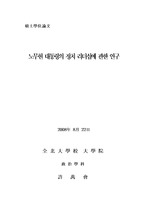

PARTNER
검증된 파트너 제휴사 자료
법학교육방법의 새로운 접근 (New Approaches to the Methods of Legal Education)
한국학술지에서 제공하는 국내 최고 수준의 학술 데이터베이스를 통해 다양한 논문과 학술지 정보를 만나보세요.
32 페이지
최초등록일 2025.06.15
최종저작일
2012.01

-
미리보기
서지정보
· 발행기관 : 안암법학회
· 수록지 정보 : 안암법학 / 37호 / 907 ~ 938페이지
· 저자명 : 최한준
초록
Legal education is the education of individuals who intend to become legal professionals or those who simply intend to use their law degree to some end, either related to law (such as politics or academic) or business.
We, the law professors, need the efficient methods of legal education, because laws are very difficult to understand. In this situation, conventional methods of legal education (including theory-oriented teaching and case- oriented teaching) need to be changed in modern complex society. Therefore, concerning the new approaches to the methods of legal education, I suggest three new points from the viewpoint of the learning motivation.
1. Teaching by Story-Type Cases As a compromised combination between theory-oriented teaching and case-oriented teaching, the teaching by textbook cases is a very significant teaching method in continental jurisdiction. A textbook case is a case derived from judicial precedents or made by lawyers (especially law professors). As a kind of this textbook case, there can be a story-type case, which has very various legal items inside one story which proceeds as time goes.
2. Legal Education using Multimedia, especially court movies Multimedia is the use of several different media to convey information (text, audio, graphics, animation, video, and interactivity).
As the information is presented in various formats, multimedia enhances user experience and makes it easier and faster to grasp information.
Presenting information in various formats is nothing new, but multimedia generally implies presenting information in various digital formats.
Multimedia finds its application in various areas including, but not limited to, education. Multimedia lets the user go through a series of presentations, text about a particular topic, and associated illustrations in various information formats. In the light of this multimedia’s character, it is realized that ‘legal education using multimedia’ has much to do with court movies, having a combination form of many multimedia's factors.
3. Legal Education by PBL (Problem-Based Learning)PBL(Problem-Based Learning) is a student-centered pedagogy in which students learn about a subject in the context of complex, multifaceted, and realistic problems. Working in groups, students identify what they already know, what they need to know, and how and where to access new information that may lead to resolution of the problem. The role of the instructor is that of facilitator of learning who provides appropriate scaffolding and support of the process, modelling of the process, and monitoring the learning. The instructor must build students confidence to take on the problem, and encourage the student, while also stretching their understanding. In the light of this conception of PBL, we must distinguish between case-oriented teaching and PBL in legal classes.
Above methods can be combined in one course in various ways according to the characteristics of each chapter. But we must be careful that methods are not to overlap with each other, treating one legal subject.영어초록
Legal education is the education of individuals who intend to become legal professionals or those who simply intend to use their law degree to some end, either related to law (such as politics or academic) or business.
We, the law professors, need the efficient methods of legal education, because laws are very difficult to understand. In this situation, conventional methods of legal education (including theory-oriented teaching and case- oriented teaching) need to be changed in modern complex society. Therefore, concerning the new approaches to the methods of legal education, I suggest three new points from the viewpoint of the learning motivation.
1. Teaching by Story-Type Cases As a compromised combination between theory-oriented teaching and case-oriented teaching, the teaching by textbook cases is a very significant teaching method in continental jurisdiction. A textbook case is a case derived from judicial precedents or made by lawyers (especially law professors). As a kind of this textbook case, there can be a story-type case, which has very various legal items inside one story which proceeds as time goes.
2. Legal Education using Multimedia, especially court movies Multimedia is the use of several different media to convey information (text, audio, graphics, animation, video, and interactivity).
As the information is presented in various formats, multimedia enhances user experience and makes it easier and faster to grasp information.
Presenting information in various formats is nothing new, but multimedia generally implies presenting information in various digital formats.
Multimedia finds its application in various areas including, but not limited to, education. Multimedia lets the user go through a series of presentations, text about a particular topic, and associated illustrations in various information formats. In the light of this multimedia’s character, it is realized that ‘legal education using multimedia’ has much to do with court movies, having a combination form of many multimedia's factors.
3. Legal Education by PBL (Problem-Based Learning)PBL(Problem-Based Learning) is a student-centered pedagogy in which students learn about a subject in the context of complex, multifaceted, and realistic problems. Working in groups, students identify what they already know, what they need to know, and how and where to access new information that may lead to resolution of the problem. The role of the instructor is that of facilitator of learning who provides appropriate scaffolding and support of the process, modelling of the process, and monitoring the learning. The instructor must build students confidence to take on the problem, and encourage the student, while also stretching their understanding. In the light of this conception of PBL, we must distinguish between case-oriented teaching and PBL in legal classes.
Above methods can be combined in one course in various ways according to the characteristics of each chapter. But we must be careful that methods are not to overlap with each other, treating one legal subject.참고자료
· 없음태그
-
자주묻는질문의 답변을 확인해 주세요

꼭 알아주세요
-
자료의 정보 및 내용의 진실성에 대하여 해피캠퍼스는 보증하지 않으며, 해당 정보 및 게시물 저작권과 기타 법적 책임은 자료 등록자에게 있습니다.
자료 및 게시물 내용의 불법적 이용, 무단 전재∙배포는 금지되어 있습니다.
저작권침해, 명예훼손 등 분쟁 요소 발견 시 고객센터의 저작권침해 신고센터를 이용해 주시기 바랍니다. -
해피캠퍼스는 구매자와 판매자 모두가 만족하는 서비스가 되도록 노력하고 있으며, 아래의 4가지 자료환불 조건을 꼭 확인해주시기 바랍니다.
파일오류 중복자료 저작권 없음 설명과 실제 내용 불일치 파일의 다운로드가 제대로 되지 않거나 파일형식에 맞는 프로그램으로 정상 작동하지 않는 경우 다른 자료와 70% 이상 내용이 일치하는 경우 (중복임을 확인할 수 있는 근거 필요함) 인터넷의 다른 사이트, 연구기관, 학교, 서적 등의 자료를 도용한 경우 자료의 설명과 실제 자료의 내용이 일치하지 않는 경우
“안암법학”의 다른 논문도 확인해 보세요!
-
집회․시위에 대한 형법 제185조 (일반교통방해죄) 적용의 문제점 33 페이지
Controversy over the general obstruction of traffic clause in the Criminal Act had been aroused as the court approved the prosecution under that provision against the participants of the candlelight r.. -
상법상 상호권 보호의 재조명 30 페이지
A trade name, if combining with a particular product, does more than a mere name, allowing one to associate it with its products and business. In particular, if such a product or service, with the bac.. -
특허침해에 대한 손해배상액으로서 실시료 상당액 36 페이지
This article studies the reasonable royalties as damages for patent infringements. Korea patent law Article 128 is for calculating damages in patent infringements. Article 128 (3) provides for patent .. -
저작권침해 어플리케이션을 판매하는 앱스토어의 책임 34 페이지
The sale of applications on the APP Store is keep growing rapidly and worldwidely and the damages of copyrighters are going to be increased enormously. However, as we see that the most of the people w.. -
법철학과 사회법 — 라드브루흐의 사회적 법사상을 중심으로 — 37 페이지
Einer der bekanntesten Rechtsphilosophen des 20. Jahrhunderts, Gustav Radbruch, war keiner der typischen Akademiker, die im Elfenbeinturm eigene Nischen finden, sondern vielmehr ein an der politischen..
찾으시던 자료가 아닌가요?
지금 보는 자료와 연관되어 있어요!
문서 초안을 생성해주는 EasyAI




